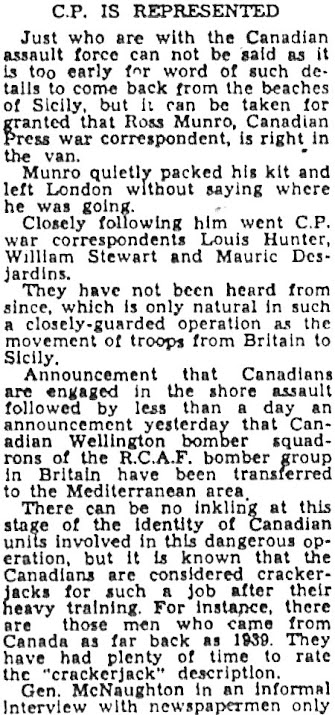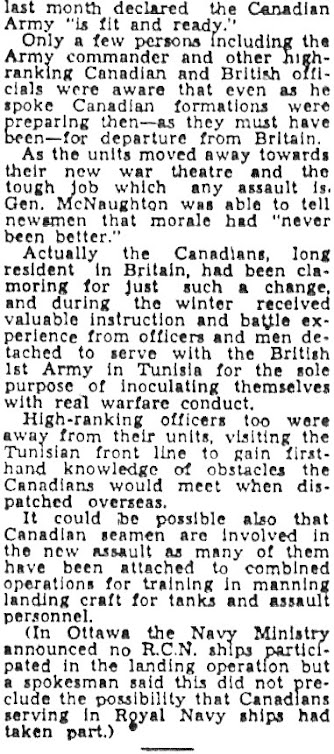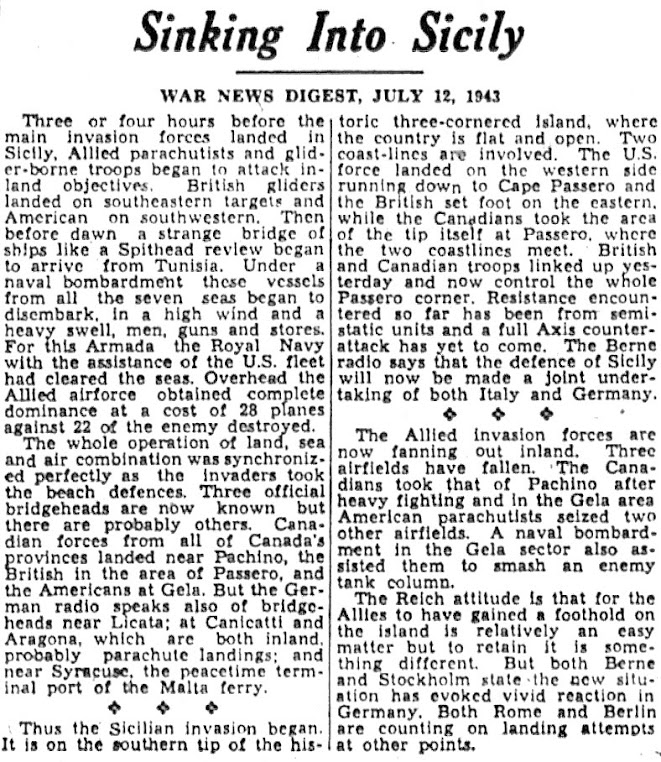In the Early Morning Hours... the Allies Strike
From the Montreal Gazette, July 10 - 12, 1943
General view of one of the invasion beaches, with Italian prisoners
being made to remove barbed-wire in the foreground, 10 July 1943.
Please click here for more photos re Sicily landings
Readers who found posts entitled "Three Months in the Mediterranean, 1943" a week or more ago, covering details from The (Montreal) Gazette, July 1 - 9, may have wondered when I'd start sharing information about the actual invasion of Sicily, aka Operation Husky, aka D-Day Sicily. "Enough with the preamble. Where's the action? When do boots hit the ground?"
The headline below says it all. And for only five cents.
The invasion date was July 10, a Saturday, and not all the war correspondents - who witnessed the events of the days and then wrote about them - got their stories neatly typed up and sent via the Atlantic cable to their newspaper Editors back in Great Britain or Canada or the U.S. (etc.) in time to make the Saturday edition. But some did as you will see below.
If there were news items published the next day, a Sunday (the Sabbath, the seventh day, a day of rest)... I haven't found them. But on Monday (!), the newspapers were as thick as a New York city phonebook. I say, good luck to all paperboys everywhere to get them folded and delivered by the usual time!
Please find below the news of the day, and the first half of the many items I found on the 12th, as well as links to other related stories and photos, especially related to our Canadians in Combined Ops - manning landing crafts near Noto and Avola, Sicily - who had their hands full from the get go in support of Monty's Eighth Army:
Please find below the news of the day, and the first half of the many items I found on the 12th, as well as links to other related stories and photos, especially related to our Canadians in Combined Ops - manning landing crafts near Noto and Avola, Sicily - who had their hands full from the get go in support of Monty's Eighth Army:
but the Luftwaffe stuck it to Allied landings anyway (north of Pachino)
Another map will follow with the July 12th news clippings, but the one below, from Londoner Clayton Marks' book, Combined Operations, will show where Canadian Army troops landed (left of Pachino and Cape Passero) with part of the British Eighth Army) and where members of RCNVR/Combined Ops manned four flotillas of landing craft (north of Pachino and Cape Passero) transported a goodly number of Monty's Eighth to shore with all of their supplies... for many days. (The ferrying of materials of war continued for approx. 4 weeks thanks to LCMs, landing craft mechanised, a workhorse of many landings during WWII).
Map from Combined Operations, page 76
And now, more news from The Gazette:
To me, after reading scores of news accounts of operations during WWII, it's understandable that Canadian war correspondents of all stripes mentioned the progress of Canadian Army troops first and foremost before touching on the role of the Canadian Navy. Once "boots hit the ground" correspondents were right behind them, sussing out a headline for their written account of the action. As we know, Ross Munro (Canadian Press, or CP) often hit the ground one second after the troops did.
All that being said, readers who wonder how their father, grandfather, uncle(s), great uncle(s), etc., who was/were in the navy fared, would sure be happy to see the final two paragraphs above, especially those whose fathers, uncles, etc., were in RCNVR/Combined Operations and manned the landing crafts that delivered the troops and Ross Munro and all their essential supplies (all materials of war) to the beaches assigned.
Allow me to share again the second last paragraph in case you missed it:
Canadian seamen, including my father, began their "training in
manning landing craft" in early 1942, in England and Scotland
The Effingham Division volunteered (the first Canadian group to do so)
"almost to the man" for Combined Operations in Dec. 1941 when at
HMCS Stadacona, Halifax. X - Doug Harrison, front row seat.
British and U.S. ships stormed the Mediterranean Sea in July 1943. Canadian ships were in Canada, perhaps even then in short supply.
"Powerful air forces" did not initially command the skies in all areas of Sicily in July, but their presence was necessary to secure safe landings in many sectors:
As we know, Allied air forces worked together to gradually take more control of the skies over Sicily and the Italian peninsula during July, 1943. Members of the Royal Canadian Air Force saw action in Sicily, and my father, serving the GEORGE Sector at a beach in what is now known as Fontane Bianche* fortuitously ran into a few Canadians at an airstrip near his humble accommodation (a limestone cave) near the beach.
He writes:
“I have no mess fanny or spoon,” I said, and the cook told me there were some fellows washing theirs up and to ask one of them for the loan of their mess fanny and spoon. So I walked over, tapped a man’s shoulder and asked if I could borrow his equipment. The man straightened up and said “sure” and it turned out to be Bill Donnelly from my own hometown of Norwich, Ontario. I got my oppo, A/B Buryl McIntyre from the cave and did the vino ever run that night. Small world. So when we had had enough Bill crawled into his hole in the ground, covered himself with mosquito netting, and we headed back to the cave. Overhead, Beaufort night fighters were giving Jerry fighters and bombers hell. We felt the courage given us by the vino and slept quite soundly in our dank old cave ‘til morning rolled around again. "Dad, Well Done" page 34
*Fontane Bianche is 10 - 11 km north of Avola, which is in the lower right section of the Combined Operations map of Sicily above. The cave was close to not only GEORGE Sector but an Allied airfield. Perhaps I'll be able to track down the location of both during to my upcoming trip to Sicily.
The Montreal Gazette shares very good art pieces re WWII. How could I resist sharing this one of a fellow showing off his seamanship skills:
A few details re the artist, Grant Macdonald, can be found here
And now, a word from our Prime Minister:
"No R.C.N. ships participated... (there is a "possibility" that) Canadians in
in Royal Navy ships had taken part." And in Canadian
Landing Craft flotillas as well, I must add
On Monday, July 12, 1943, quite a few articles re the invasion of Sicily appeared in The Gazette:
"Canadians Land Practically Unopposed At Pachino" refers only to the members of the Canadian Army. Members of the Royal Canadian Navy Volunteer Reserve, while landing British troops (Montgomery's 8th Army) on the eastern shores of Sicily, were opposed by the Luftwaffe every two hours for three straight days in some sectors. Details follow the map below:
If (!), as the last paragraph above states, Allied planes were trying to make a home for themselves 10 - 15 miles inland, who was guarding the eastern shores where Canadians in Combined Ops (for example) were transporting troops and materials of war ashore south of Syracuse?
Lt. Cdr. Jake Koyle (RCNVR/Combined Ops) writes in memoirs:
When the transport ships arrived off the beaches at dawn small arms opposition had been wiped out by the assault forces but coastal artillery batteries inland were still firing, while a cruiser, destroyer and a monitor were bombarding from port and starboard wings of the anchorage. By 0730 all was quiet - terribly quiet. Everyone expected enemy aircraft from moment to moment and the anticipation intensified the stillness in spite of the intense activity, but it was not until 1130 that the first Italian fighter was seen flying low, hotly pursued by two Spitfires; and not until 1330 did a bombing attack develop. Then one bomber dropped a stick on the sector of "GEORGE" beaches worked by the 80th Flotilla, narrowly missing Lieut. Koyle who was on the beach at the time between an LCT (landing craft, tanks) and an LST (landing ship, tanks) which both suffered heavy casualties.
This is indeed one of the most extraordinary 'narrow escape' stories on record. Lieut. Koyle had beached forty feet from an LCT on the one side and an LST on the other. The larger craft, because of their greater draft, were further off the beach itself when a stick of three bombs fell immediately ahead of Lieut. Koyle's LCM. The LCT was destroyed and her entire personnel killed or fatally wounded. All the bridge personnel of the LST were wiped out. But in the little unarmoured LCM, no one was scratched.
The hands on the beach with beach lines to steady the craft were knocked down and Lieut. Koyle was blown back into the well deck, but the shrapnel passed over them. After such a severe shock, the LCM personnel deserve much credit for the rapid and efficient help they gave the LST's wounded, whom Lieut. Koyle removed to the hospital ship "TALAMBA".
It was with great relief that the troopers (troop ships, e.g., U.S. Liberty ships) who had landed the assault forces were sailed away. There was still a tempting assemblage of shipping off the beaches, perhaps fifty vessels, and the stores they carried were vital to the operation of the 8th Army now advancing towards Syracuse.
It was with great relief that the troopers (troop ships, e.g., U.S. Liberty ships) who had landed the assault forces were sailed away. There was still a tempting assemblage of shipping off the beaches, perhaps fifty vessels, and the stores they carried were vital to the operation of the 8th Army now advancing towards Syracuse.
At 1530 the first serious air raid took place but a number of dive bombers and medium bombers achieved no success with attacks which were directed mainly against transports. From then on the blitz continued throughout the night and at frequent intervals during the next 48 hours.
Although the bombing attacks were so numerous, there were never many aircraft in any one attack - about thirty aircraft, mostly German, in the heaviest raids on "HOW" sector - and the raids were surprisingly unsuccessful. Not until the evening of the 11th was any ship sunk or severely damaged. Then, in a dusk attack, dive bombers selected a hospital ship lying lit up some distance to seaward of its transport anchorage and sunk her in twenty minutes.
According to a record kept by a stoker of the 81st Flotilla, there were twenty-three raids on "HOW" and "GEORGE" sectors in the first three days.
Combined Operations by Londoner Clayton Marks, pages 176 - 177
Joe Watson (RCNVR/Comb. Ops) of Simcoe, coxswain on my father's LCM, shared information about the landings in Sicily (at GEORGE Sector) during a later interview:
Article was shared with me by Joe Watson's granddaughter, Simcoe area.
“We were bombed 36 times in the first 72 hours," Dad says in memoirs
And now, back to The Gazette. And for some reason one paragraph relating to the role of Canadians in Combined Ops has been highlighted - about 2/3s of the way down - by someone:
Conflicting accounts exist (re "negligible losses" above) related to the Allied gliders:
We fired at everything. I saw P38s, German and Italian fighters and my first dogfights. Stukas blew up working parties on the beach once when I was only about one hundred feet out. Utter death and carnage. Our American gun crews had nothing but coffee for three or four days and stayed close to their guns all the time. I give them credit.
"Dad, Well Done" by D. Harrison, page 31
Back to The Gazette's account:
More to soon follow from July 12 and 13, 1943.
Everyone in the military, on sea or land or in the air, loves hearing that "the reinforcements are coming!"
Ross Munro, well-respected Canadian war correspondent, 'almost walked in' "four miles southwest of Pachino." I can hear Canadian sailors around the corner, northeast of Pachino, saying, "Hey... wait just a doggone minute"(!):
Two 'old vets' have been mentioned above; centre, Clayton 'Red' Marks;
far right, Jake Koyle (former Lt. Cdr. of 80th Flotilla). Left, Ed Corbett,
also in the 80th flotilla. As found in Combined Operations, page 8
Questions and comments can be addressed to Gord Harrison at gordh7700@gmail.com
Please click here to view Research: Three Months in the Mediterranean, 1943 (4)
Unattributed Photos GH
.jpg)
















































No comments:
Post a Comment